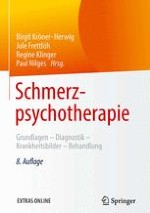
2017 | OriginalPaper | Buchkapitel
1. Schmerz als biopsychosoziales Phänomen – eine Einführung
verfasst von : Prof. Dr. Dipl.-Psych. B. Kröner-Herwig
Erschienen in: Schmerzpsychotherapie
Verlag: Springer Berlin Heidelberg

2017 | OriginalPaper | Buchkapitel
verfasst von : Prof. Dr. Dipl.-Psych. B. Kröner-Herwig
Erschienen in: Schmerzpsychotherapie
Verlag: Springer Berlin Heidelberg